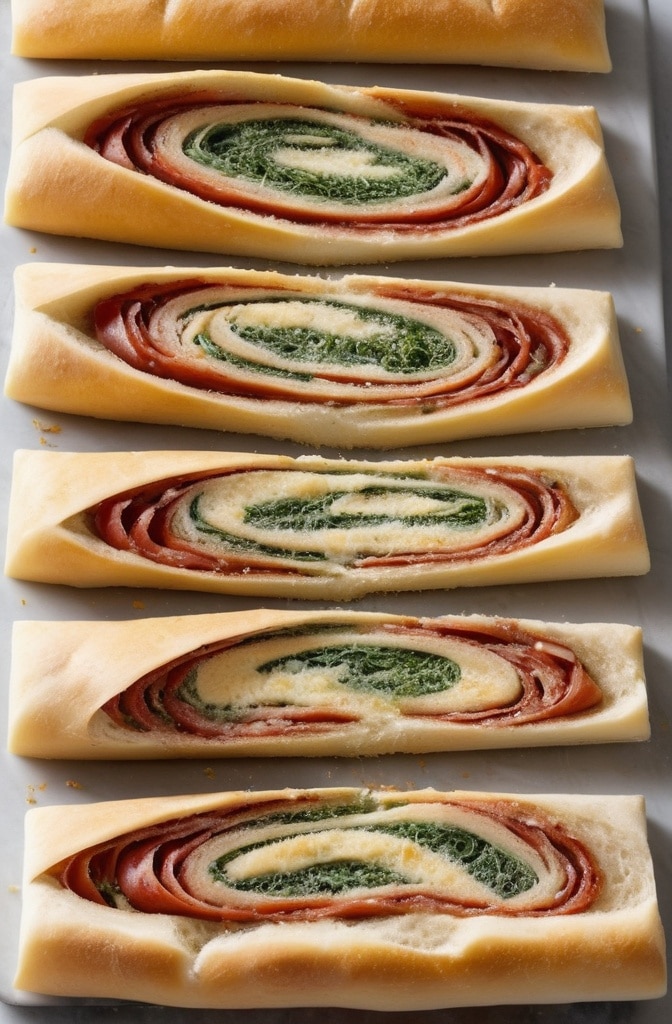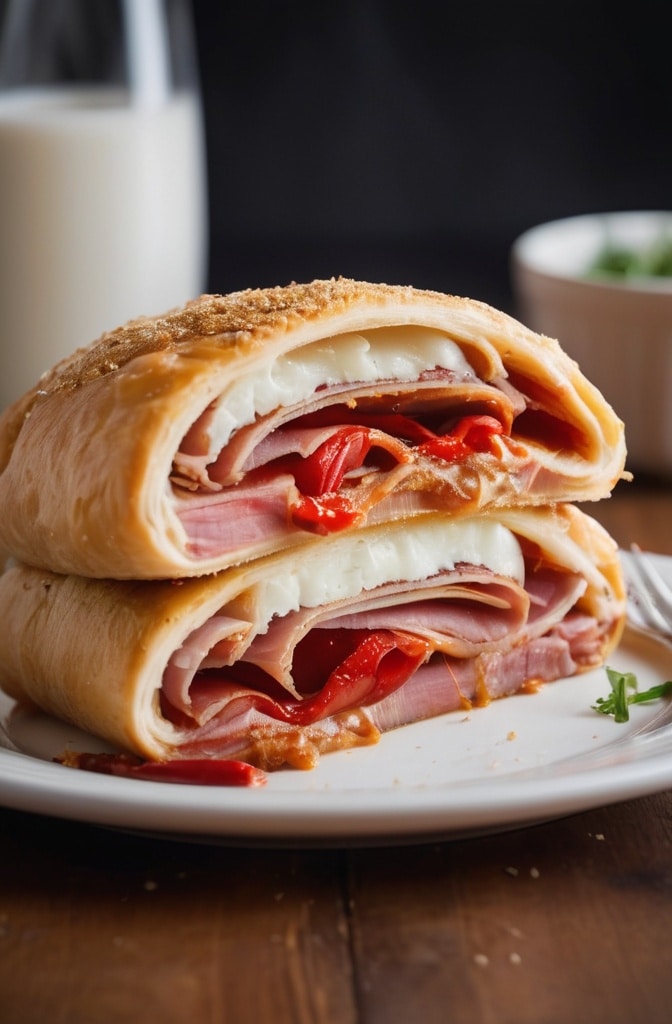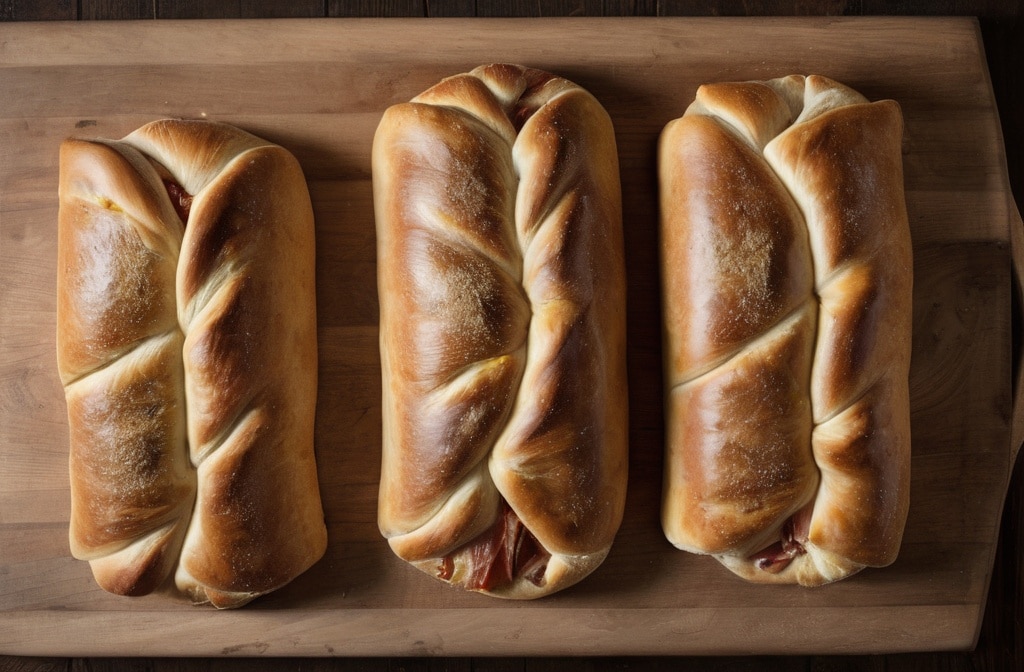Italian Stromboli. I’ll never forget the first time I watched my nonna roll one up like it was a scroll of ancient wisdom—saucy secrets folded tight inside a pillowy dough blanket. It was a Sunday, and the house already smelled like roasted garlic by 10 am. She slapped the dough down like it owed her money and said, “This? This is pizza’s more interesting cousin.”
Italian Stromboli is a rolled, baked, filled bread—crispy outside, gooey inside—that captures everything glorious about Italian-American cooking. It’s part pizza, part sandwich, part culinary magic trick. Think thin dough, layered with cured meats, melty cheese, herbs, and a whisper of sauce—then all rolled up like a savory jelly roll, baked until golden and bubbling at the seams.
Italian Stromboli is special because it’s chaos contained in a crust. Unlike a calzone, which is folded, Stromboli is rolled. And that small difference changes everything—from texture to filling distribution. This one bakes like a dream, crisps up along the edges, and slices into perfect pinwheels off flavour.
Ingredients & Substitutions
Italian Stromboli dough should start with the right flour. Bread flour is best—its high protein content gives a chewy, structured base. But if all-purpose is all ya got, it’ll work. Just don’t expect quite the same spring in your step… or crust.
Italian Stromboli filling begins with cured meats. Think genoa salami, spicy capicola, pepperoni, prosciutto. Don’t go overboard. Two or three types, max. Too much fat and it turns into a greasy slip-n-slide.
The Italian Stromboli cheese should stretch and melt. Mozzarella’s the classic choice. Use low-moisture shredded mozz to avoid soggy bottoms (no one wants a soggy bottom, ever). Add provolone or fontina for more bite.
Italian Stromboli sauce is optional. Yep—some purists skip it inside. Me? I use a very thin layer of homemade marinara. Just enough to kiss the dough, not drench it. Too much and you’ll be mopping up your dinner with a fork.
Italian Stromboli extras can include sautéed onions, roasted red peppers, banana peppers, fresh basil, or spinach. If you add veggies, wring them out or pre-cook to ditch the extra water. Damp veggies = steamed Stromboli. Nah, no thanks.
Substitutions? Sure.
- Gluten-free? Use a high-quality gluten-free pizza dough.
- Dairy-free? Try a vegan mozzarella that melts (some don’t… test first).
- Meatless? Load it up with grilled eggplant, mushrooms, and spinach. But again: moisture is the enemy. Roast or sauté ‘em first.
Step-by-Step Instructions
Italian Stromboli starts with dough prep. Let your pizza dough rest at room temp for 30–60 minutes before rolling. Cold dough fights back. Warm dough stretches like a sleepy cat.
Italian Stromboli dough should be rolled into a rectangle. Not a circle. About 10 x 14 inches. Thick enough to hold fillings, thin enough to roll. Too thin? It tears. Too thick? It’s a loaf, not a roll.
Italian Stromboli gets layered carefully. First cheese, then meats, then sauce (if using), then extras. Always leave a 1-inch border around the edges. That gap is your glue zone.
Italian Stromboli needs to be rolled tightly, but not choked. Think cinnamon roll, not rug. Start on the long side and roll slowly, tucking as you go. Pinch seams closed. If it’s oozing, you overfilled.
Italian Stromboli is sealed with a quick egg wash. Beat one egg with a splash of water, and brush the top. Sprinkle with Parmesan, garlic powder, and dried oregano if you’re feeling fancy. Don’t forget to cut slits on top—steam needs somewhere to go.
Italian Stromboli bakes at 400°F (200°C) for 25–30 minutes. Place seam-side down on a parchment-lined sheet. When it’s golden brown and smells like an Italian deli collided with a pizzeria—it’s ready.
Let it rest for at least 10 minutes before slicing. Don’t rush. Cutting it too soon = cheese lava everywhere. Trust me. I’ve made that mistake more than once.
Variations? Absolutely.
- Add crushed red pepper for heat.
- Swap marinara with pesto or sun-dried tomato spread.
- Try buffalo chicken and blue cheese for an American twist.

Cooking Techniques & Science
Italian Stromboli works because of heat, moisture control, and gluten structure.
Italian Stromboli crust gets crispy because high-heat baking triggers the Maillard reaction. That’s chef-speak for golden-brown perfection. Egg wash helps. It seals the dough and encourages browning.
The Italian Stromboli filling stays inside because of the rolling technique. If you don’t tuck and pinch properly, fillings escape like jailbirds. And don’t skip vent slits—they release steam and prevent ballooning.
Italian Stromboli cheese stretches because of casein proteins. Low-moisture mozzarella is best because it’s less watery, more stable. Fresh mozz melts too fast and soaks the dough.
Italian Stromboli dough rises thanks to yeast and gluten strands. Letting it rest before rolling relaxes the gluten. That makes it easier to shape without tearing.
Tools matter, too.
- A pizza stone = crispier bottom.
- A bench scraper = your best friend when rolling and lifting dough.
- A serrated knife = clean slices, no squish.
Serving & Pairing Suggestions
Italian Stromboli slices beautifully into pinwheels. Use a serrated bread knife. Let it cool a bit so the cheese doesn’t drag out like a mozzarella magic trick.
Italian Stromboli loves marinara on the side. Warm, not boiling. Dip, bite, smile. Repeat.
Italian Stromboli pairs great with a crisp green salad, balsamic vinaigrette, maybe a few shaved Parm curls. Keeps it balanced. Ya know, like you’re pretending to eat healthy.
Italian Stromboli and drinks? Go Italian red. Chianti, Montepulciano, or even a Lambrusco if you’re feeling bubbly. For beer lovers, a crisp lager or a malty amber ale hits the spot.
Italian Stromboli leftovers reheat beautifully. Oven only. No microwave unless you like soggy sadness. Wrap it in foil, 350°F for 10 minutes, good as new.

Conclusion
Italian Stromboli is comfort food with swagger. It’s not just rolled dough—it’s a celebration of Italian flavours packed into every bite. Meaty. Cheesy. Crispy. It’s got layers, literally and metaphorically.
Italian Stromboli rewards technique. A little practice goes a long way. Pay attention to moisture, rolling, and baking time. Respect the dough, and it’ll respect you.
Italian Stromboli is endlessly flexible. Classic or creative, meat or veggie, spicy or sweet—once you nail the method, the possibilities are wild.
Italian Stromboli isn’t hard. But it demands care. From flour choice to final slice, every step adds flavour. And once you master it? You’ll crave it again and again.
FAQs
Can I make Italian Stromboli ahead of time?
Yes. Assemble, wrap tightly, and refrigerate up to 24 hours before baking. Let it sit at room temp for 20–30 minutes before hitting the oven. Or freeze it unbaked for up to 1 month—thaw overnight in fridge before baking.
Why is my Stromboli soggy in the middle?
Too much sauce or wet ingredients. Also, underbaking. Use low-moisture cheese, sauté veggies first, and don’t overload the dough. Bake until deeply golden, and let it rest before slicing.
What’s the difference between Stromboli and calzone?
Calzone is folded like a turnover, sealed along the edge. Stromboli is rolled, like a jelly roll. Also, calzones often include ricotta. Stromboli rarely does.
Can I use store-bought pizza dough?
Absolutely. Just let it rest at room temp before rolling. Cold dough shrinks and tears. A little olive oil on your hands helps too—keeps things smooth.
How do I stop the cheese from leaking out?
Don’t overfill. Roll tightly. Pinch seams well and always bake seam-side down. Egg wash helps seal the deal, and vent slits keep the pressure in check.

Olivia P. is a seasoned food blogger at Tastywink, sharing delicious, easy-to-follow recipes inspired by him passion for home cooking. With years of culinary blogging experience, he brings flavor, creativity, and a personal touch to every dish.
